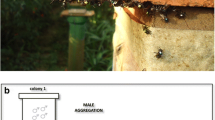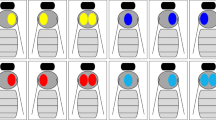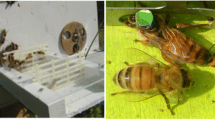Abstract
Honeybee queens (Apis mellifera) show extreme levels of polyandry, but the evolutionary mechanisms underlying this behaviour are still unclear. The “sperm-limitation hypothesis”, which assumes that high levels of polyandry are essential to get a lifetime sperm supply for large and long-lived colonies, has been widely disregarded for honeybees because the semen of a single male is, in principle, sufficient to fill the spermatheca of a queen. However, the inefficient post-mating sperm transfer from the queen’s lateral oviducts into the spermatheca requires multiple matings to ensure an adequate spermatheca filling. Males of the African honeybee subspecies A. m. capensis have fewer sperm than males of the European subspecies A. m. carnica. Thus, given that sperm limitation is a cause for the evolution of multiple mating in A. mellifera, we would expect A. m. capensis queens to have higher mating frequencies than A. m. carnica. Here we show that A. m. capensis queens indeed exhibit significantly higher mating frequencies than queens of A. m. carnica, both in their native ranges and in an experiment on a North Sea island under the same environmental conditions. We conclude that honeybee queens try to achieve a minimum number of matings on their mating flights to ensure a sufficient lifetime sperm supply. It thus seems premature to reject the sperm-limitation hypothesis as a concept explaining the evolution of extreme polyandry in honeybees.
Similar content being viewed by others
References
Alber M, Jordan M, Ruttner H (1955) Von der Paarung der Honigbiene. Z Bienenforsch 3:1–28
Allsopp MH, Hepburn HR (1997) Swarming, supersedure and the mating system of a natural population of honeybees (Apis mellifera capensis). J Apic Res 36:41–48
Baer B, Schmid-Hempel P (2000) The artificial insemination of bumblebee queens. Insectes Soc 47:183–187
Boomsma JJ, Ratnieks FLW (1996) Paternity in eusocial Hymenoptera. Philos Trans R Soc Lond B 351:947–975
Bresslau E (1905) Der Samenblasengang der Bienenkönigin. Zool Anz 29:299–323
Buys B (1990) Features of basic reproduction in drones and queens of the Cape honeybee Apis mellifera capensis. In: Anderson RH, Buys B (eds) Proceedings of the International Beekeepers’ Symposium: Bees and beekeeping in Southern Africa, Posa & WPBA, Cape Town, pp 106–109
Cole BJ (1983) Multiple mating and the evolution of social behaviour in the Hymenoptera. Behav Ecol Sociobiol 12:191–201
Cornuet JM, Aries F (1980) Number of sex alleles in a sample of honeybee colonies. Apidologie 11:87–93
Crozier RH, Fjerdingstad EJ (2001) Polyandry in social Hymenoptera—disunity in diversity? Ann Zool Fenn 38:267–285
Crozier RH, Page RE (1985) On being the right size: male contributions and multiple matings in social Hymenoptera. Behav Ecol Sociobiol 18:105–115
Crozier RH, Pamilo P (1996) Evolution of social insect colonies. Oxford University Press, Oxford
Estoup A, Solignac M, Harry M, Cornuet JM (1993) Characterization of (GT)-n and (CT)-n microsatellites in two insect species: Apis mellifera and Bombus terrestris. Nucleic Acids Res 21:1427–1431
Estoup A, Solignac M, Cornuet JM (1994) Precise assessment of the number of patrilines and of genetic relatedness in honeybee colonies. Proc R Soc Lond B 258:1–7
Estoup A, Garnery L, Solignac M, Cornuet JM (1995) Microsatellite variation in honey bee (Apis mellifera L.) populations: hierarchical genetic structure and test of the infinite allele and stepwise mutation models. Genetics 140:679–695
Fjerdingstad EJ, Boomsma JJ (1998) Multiple mating increases the sperm stores of Atta colombica leafcutter ant queens. Behav Ecol Sociobiol 42:257–261
Fuchs S, Moritz RFA (1998) Evolution of extreme polyandry in the honeybee Apis mellifera L. Behav Ecol Sociobiol 45:269–275
Fuchs S, Schade V (1994) Lower performance in honeybee colonies of uniform paternity. Apidologie 25:155–168
Gadau J, Strehl CP, Oettler J, Holldobler B (2003) Determinants of intracolonial relatedness in Pogonomyrmex rugosus (Hymenoptera; Formicidae): mating frequency and brood raids. Mol Ecol 12:1931–1938
Gary NE (1992) Activities and behaviour of honeybees. In: Graham JM (ed) The hive and the honey bee. Dadant, Hamilton, Ill, pp 269–372
Goodisman MAD, Matthews RW, Crozier RH (2002) Mating and reproduction in the wasp Vespula germanica. Behav Ecol Sociobiol 51:497–502
Haberl M, Tautz D (1998) Sperm usage in honey bees. Behav Ecol Sociobiol 42:247–255
Hamilton WD (1964) The genetical evolution of social behaviour. I and II. J Theor Biol 7:1–52
Hamilton WD (1987) Kinship, recognition, disease and intelligence: constraints of social evolution. In: Ito Y, Brown JL, Kikkawa J (eds) Animal societies. Japanese Scientific Society, Tokyo, pp 81–102
Hepburn HR, Crewe RM (1991) Portrait of the Cape honeybee, Apis mellifera capensis. Apidologie 22:567–580
Hepburn HR, Jacot-Guillarmod A (1991) The Cape honeybee and the fynbos biome. S Afr J Sci 87:70–73
Hölldobler B, Wilson EO (1990) The ants. Belknap Press of Harvard University Press, Cambridge
Koeniger G (1976) Einfluss der Kopulation auf den Beginn der Eiablage bei der Bienenkönigin (Apis mellifera L.). Apidologie 7:343–355
Koeniger G (1981) In welchem Abschnitt des Paarungsverhaltens der Bienenkönigin findet die Induktion der Eiablage statt? Apidologie 12:329–343
Koeniger G, Ruttner F (1989) Mating behaviour and anatomy of the reproductive organs. In: Moritz RFA (ed) The instrumental insemination of the queen bee. Apimondia, Bucharest, p 19
Koeniger G, Koeniger N, Pechhacker H, Ruttner F, Berg S (1989) Assortative mating in a mixed population of European honeybees, Apis mellifera ligustica and Apis mellifera carnica. Insectes Soc 36:129–138
Koeniger G, Koeniger N, Mardan M, Punchihewa R, Otis G (1990) Numbers of spermatozoa in queens and drones indicate multiple mating of queens in Apis andreniformis and Apis dorsata. Apidologie 21:281–286
Koeniger G, Koeniger N, Tingek S, Kelitu A (2000) Mating flights and sperm transfer in the dwarf honeybee Apis andreniformis (Smith, 1858). Apidologie 31:301–311
Koeniger N, Koeniger G, Wongsiri S (1989) Mating and sperm transfer in Apis florea. Apidologie 20:413–418
Koeniger N, Koeniger G, Mardan M (1994) Mimicking a honeybee queen? Vespa affinis indosinensis (Perez 1910) hunts drones of Apis cerana F. 1793. Ethology 98:149–153
Kraus FB, Neumann P, Praagh J van, Moritz RFA (2003) Male mating success of honeybee colonies (Apis mellifera L.). J Evol Biol 16:903–913
Laidlaw HH, Page RE (1984) Polyandry in the honey bees (Apis mellifera L.): sperm utilization and intracolony genetic relationships. Genetics 108:985–997
Mackensen O (1947) Effect of carbon dioxide on initial oviposition of artificially inseminated and virgin queen bees. J Econ Entomol 40:344–349
Michener CD (2000) The bees of the world. Johns Hopkins University Press, Baltimore, Md
Moritz RFA (1986) Intracolonial worker relationship and sperm competition in the honeybee (Apis mellifera). Experientia 42:445–448
Moritz RFA, Kryger P, Koeniger G, Koeniger N, Estoup A, Tingek S (1995) High degree of polyandry in Apis dorsata queens detected by DNA microsatellite variability. Behav Ecol Sociobiol 37:357–363
Moritz RFA, Kryger P, Allsopp M (1996) Competition for royalty in bees. Nature 384:521–522
Neumann P, Moritz RFA (2000) Testing genetic variance hypotheses for the evolution of polyandry in the honeybee (Apis mellifera L.). Insectes Soc 47:271–279
Neumann P, Praagh JP van, Moritz RFA, Dustmann JH (1999a) Testing the reliability of a potential island mating apiary using DNA microsatellites. Apidologie 30:257–276
Neumann P, Moritz RFA, Praagh JP van (1999b) Queen mating frequency in different types of honeybee mating apiaries. J Apic Res 38:11–18
Neumann P, Moritz RFA, Mautz D (1999c) Using DNA microsatellites for maternity testing in honeybees (Apis mellifera L.). Apidologie 30:505–512
Oldroyd BP, Rinderer TE, Harbo JR, Buco SM (1992) Effects of intracolonial genetic diversity on honey bee (Hymenoptera: Apidae) colony performance. Ann Entomol Soc Am 85:335–343
Oldroyd BP, Clifton MJ, Wongsiri S, Rinderer TE, Sylvester HA, Crozier RH (1997) Polyandry in the genus Apis, particulary Apis andreniformis. Behav Ecol Sociobiol 40:17–26
Page RE, Robinson GE, Fondrk MK (1989) Genetic specialists, kin recognition and nepotism in honey-bee colonies. Nature 338:576–579
Page RE, Robinson GE, Fondrk MK, Nasr ME (1995) Effects of worker genotypic diversity on honey bee colony development and behaviour (Apis mellifera L.). Behav Ecol Sociobiol 36:387–397
Palmer KA, Oldroyd BP (2000) Evolution of multiple mating in the genus Apis. Apidologie 31:235–248
Palmer KA, Oldroyd BP (2001) Mating frequencies in Apis florea revisited (Hymenoptera, Apidae). Insectes Soc 48:40–43
Pamilo P (1991) Life span of queens in the ant Formica exsecta. Insectes Soc 38:111–119
Pamilo P (1993) Polyandry and allele frequency differences between the sexes in the ant Formica aquilonia. Heredity 70:472–480
Ribbands CR (1953) The behaviour and social life of honeybees. Bee Research Association, London
Rinderer T, Collins M, Pesante D (1985) A comparison of Africanized and European drones: weight, mucus gland and seminal vesicle weights, and count of spermatozoa. Apidologie 16:407–412
Röseler PF (1973) Die Anzahl Spermien im Receptaculum seminis von Hummelköniginnen (Hymenoptera, Apidae, Bombinae). Apidologie 4:267–274
Rowe DJ, Rinderer TE, Stelzer JA, Oldroyd BP, Crozier RH (1997) Seven polymorphic microsatellite loci in honeybees (Apis mellifera). Insectes Soc 44:85–93
Ruttner F (1956) The mating of the honey bee. Bee World 37:2–24
Ruttner F (1988) Biogeography and taxonomy of honeybees. Springer, Berlin Heidelberg New York
Ruttner H (1980) Haltung der Königinnen während der Paarungszeit. In: Ruttner F (ed) Königinnenzucht. Apimondia, Bucharest, pp 225–267
Schlüns H, Schlüns EA, Praagh JP van, Moritz RFA (2003) Sperm numbers in drone honeybees (Apis mellifera) depend on bodysize. Apidologie 34 (in press)
Schmid-Hempel P (1994) Infection and colony variability in social insects. Philos Trans R Soc Lond B 346:313–321
Seeley T, Seeley R, Akratanakul P (1982) Colony defense strategies of the honeybee in Thailand. Ecol Monogr 52:43–63
Tarpy DR, Nielsen DI (2002) Sampling error, effective paternity, and estimating the genetic structure of honey bee colonies (Hymenoptera: Apidae). Ann Entomol Soc Am 95:513–528
Tarpy DR, Page RE (2001) The curious promiscuity of honey bees (Apis mellifera): evolutionary and behavioural mechanisms. Ann Zool Fenn 38:255–265
Tarpy DR, Page RE (2002) Sex determination and the evolution of polyandry in honey bees (Apis mellifera). Behav Ecol Sociobiol 52:143–150
Wattanachaiyinhcharoen W, Oldroyd BP, Wongsiri S, Palmer K, Paar S (2003) A scientific note on the mating frequency of Apis dorsata Fabricius. Apidologie 34:85–86
Wille H (1974) Bienenkrankheiten. In: Fischer G, Gerig L, Kobel F, Luterbacher W, Maurizio A, Moser K, Schäfer H, Schaer E. Wille H, Wipfli E, Wipfli P (eds) Der Schweizerische Bienenvater. Aarau, Frankfurt am Main, pp 298–299
Wilson EO (1971) The insect societies. Harvard University Press, Cambridge, Mass
Winston (1987) The biology of the honeybee. Harvard University Press, Cambridge, Mass
Woyke J (1962) Natural and artificial insemination of queen honeybees. Bee World 43:21–25
Woyke J (1964) Causes of repeated mating flights by queen honeybees. J Apic Res 3:17–23
Acknowledgements
We wish to thank N. Koeniger and S. Fuchs for providing the A. m. capensis queens for the experiments on the island of Neuwerk. Appreciation is also expressed to S. Härtel for the A. m. capensis samples from the Western Cape, and to K. Heßler and P. Leibe for technical assistance. Financial support was granted by the EU BABE network (F.B.K., R.F.A.M.) and the DFG (P.N., R.F.A.M.). All experiments and beekeeping complied with the laws of Germany.
Author information
Authors and Affiliations
Corresponding author
Additional information
Communicated by R.E. Page
Rights and permissions
About this article
Cite this article
Kraus, F.B., Neumann, P., van Praagh, J. et al. Sperm limitation and the evolution of extreme polyandry in honeybees (Apis mellifera L.). Behav Ecol Sociobiol 55, 494–501 (2004). https://doi.org/10.1007/s00265-003-0706-0
Received:
Revised:
Accepted:
Published:
Issue Date:
DOI: https://doi.org/10.1007/s00265-003-0706-0




